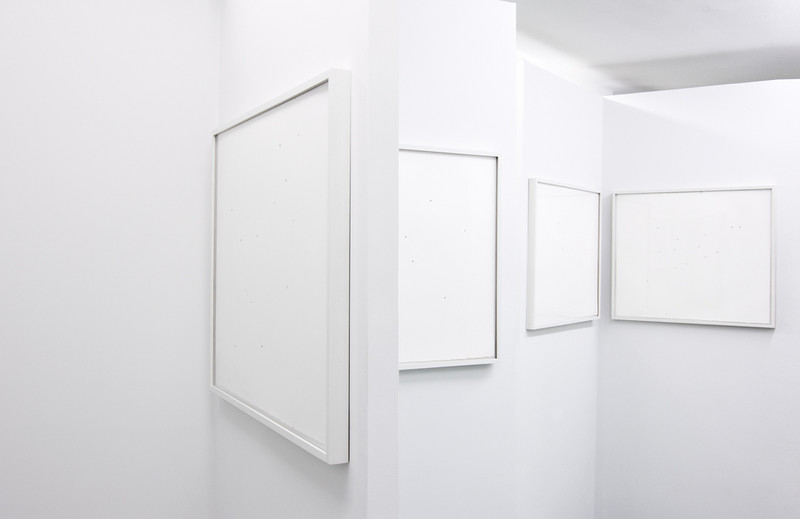Egan Frantz and Cindy Hinant
17 Apr - 01 May 2011
EGAN FRANTZ AND CINDY HINANT
Used Youth
Organized by Nicolás Guagnini
17 April – 1 May, 2011
Chance operations, mythically handed down by John Cage to Kaprow and the founders of New York Fluxus, have generated innumerable radicalities. The checkmate of the monochrome has been proposed as a de-alienating machine since Rodchenko declared in 1921, “I reduced painting to its logical conclusion and exhibited three canvases: red, blue, and yellow. I affirmed: this is the end of painting.”
Post-1968 tradition claims that in denouncing alienation, art fulfills its critical and contestatory mandate. Conversely, it can be argued that alienating technology that posits the advance of the apparatus over our form of life may actually enhance communication, fulfilling Brecht’s prophecy: that the users be producers. Revolutions start on Facebook.
Democratized means of production, brought about by ever-cheaper technology, has given voice to those who previously lacked a platform – hence the rise of Third World cinema. The utopian/dystopian duality suggested by the proliferation of screens in our experience and our pockets is beside the point; capital populates these screens faster than we can repurpose them. It is we who are repurposed as consumers at all times. Alienation is our form of life.
Is there a poetics of alienation for those born in the 1980’s? Can alienation be a productive technology of the self? Can we superimpose a potential poetics of alienation on the historical charges contained in the traditional media “drawing”?
Egan looks at the numbers on the screen and keeps rearranging them. The exercise goes on for a while, until all potential meanings have been purged. The undertaking can be tedious; after all, numbers on a two-dimensional surface tend to generate systems. When no logic can be discerned, no connection made, and the numbers will yield no figure, he hits the print button. All other decisions pertaining to the document, paper, size, and frame, are just artistic, precise and customary, in order to enhance the void proposed by the arrangements.
Cindy doodles in bed. The repeated shape is a minuscule heart. Any time the hearts organize themselves in patterns, lines, or shapes, the criteria is to devolve them into neutrality. The results are solid, flat surfaces. To submit to hours of a laborious and repetitive task, she watches television on her laptop; old cartoons, past episodes of Gossip Girl, and trash programming available for free on the internet. The scene presents a protracted and protected preteen state of being. At times, there is a gestaltist accident that won’t be repressed. Language emerges, visually suspended between the anger of Lee Lozano and the Michauxian moment in which calligrams become ideograms – that is, signs. Fuck.
Used Youth
Organized by Nicolás Guagnini
17 April – 1 May, 2011
Chance operations, mythically handed down by John Cage to Kaprow and the founders of New York Fluxus, have generated innumerable radicalities. The checkmate of the monochrome has been proposed as a de-alienating machine since Rodchenko declared in 1921, “I reduced painting to its logical conclusion and exhibited three canvases: red, blue, and yellow. I affirmed: this is the end of painting.”
Post-1968 tradition claims that in denouncing alienation, art fulfills its critical and contestatory mandate. Conversely, it can be argued that alienating technology that posits the advance of the apparatus over our form of life may actually enhance communication, fulfilling Brecht’s prophecy: that the users be producers. Revolutions start on Facebook.
Democratized means of production, brought about by ever-cheaper technology, has given voice to those who previously lacked a platform – hence the rise of Third World cinema. The utopian/dystopian duality suggested by the proliferation of screens in our experience and our pockets is beside the point; capital populates these screens faster than we can repurpose them. It is we who are repurposed as consumers at all times. Alienation is our form of life.
Is there a poetics of alienation for those born in the 1980’s? Can alienation be a productive technology of the self? Can we superimpose a potential poetics of alienation on the historical charges contained in the traditional media “drawing”?
Egan looks at the numbers on the screen and keeps rearranging them. The exercise goes on for a while, until all potential meanings have been purged. The undertaking can be tedious; after all, numbers on a two-dimensional surface tend to generate systems. When no logic can be discerned, no connection made, and the numbers will yield no figure, he hits the print button. All other decisions pertaining to the document, paper, size, and frame, are just artistic, precise and customary, in order to enhance the void proposed by the arrangements.
Cindy doodles in bed. The repeated shape is a minuscule heart. Any time the hearts organize themselves in patterns, lines, or shapes, the criteria is to devolve them into neutrality. The results are solid, flat surfaces. To submit to hours of a laborious and repetitive task, she watches television on her laptop; old cartoons, past episodes of Gossip Girl, and trash programming available for free on the internet. The scene presents a protracted and protected preteen state of being. At times, there is a gestaltist accident that won’t be repressed. Language emerges, visually suspended between the anger of Lee Lozano and the Michauxian moment in which calligrams become ideograms – that is, signs. Fuck.

